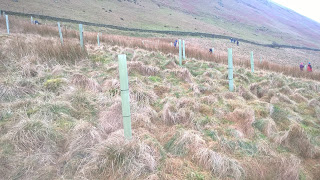I used one of my days to help with Friends of the Lake District's... Fell Care Force Tree Planting Day... on February 8th. See link below for more information.
https://www.friendsofthelakedistrict.org.uk/high-borrowdale
The ongoing project will ultimately involve planting 5200 native trees at High Borrowdale. This land, acquired by Friends of The Lake District in 2002, is located north of Kendal and south of Shap. It is also within the newly extended area of the Lake District National Park.
A good turn out of over 50 volunteers were at the Hucks Brow layby on the A6 (GR553030) close to the track that leads to High Borrowdale.
Tools for the job!
The mile long walk to High Borrowdale.
High Borrowdale is within the locality described by Alfred Wainwright as the most beautiful valley outside the Lake District.
By planting oak, alder, willow, hawthorn, rowan and holly amongst other tree species, a native woodland will be created.
This will not only enhance the landscape and habitats but tree roots, once established, will help to combat further erosion. This should reduce the risk of landslides that caused so much damage here in December 2015.
Struggling up the slope with a bulk bag full of tree tubes and stakes.
Looks enjoyable!
One of the sympathetically restored barns, undertaken by Friends of the Lake District, at High Borrowdale in which the trees to be planted are stored.
By planting oak, alder, willow, hawthorn, rowan and holly amongst other tree species, a native woodland will be created.
This will not only enhance the landscape and habitats but tree roots, once established, will help to combat further erosion. This should reduce the risk of landslides that caused so much damage here in December 2015.
Looks enjoyable!
One of the sympathetically restored barns, undertaken by Friends of the Lake District, at High Borrowdale in which the trees to be planted are stored.
Like the wildflowers we planted in Grasmere...See a previous post...The alder trees are plug plants, making them easier to plant.
A newly planted alder...
...complete with tube.
In total more than 600 trees were planted, staked and tubed on the day.
A well earned break and you can get 4G here! I enjoyed my day in High Borrowdale, felt a real sense of achievement, and look forward to working with Friends of the Lake District again.
R.Wicksteed.
A newly planted alder...
...complete with tube.
In total more than 600 trees were planted, staked and tubed on the day.
A well earned break and you can get 4G here! I enjoyed my day in High Borrowdale, felt a real sense of achievement, and look forward to working with Friends of the Lake District again.
R.Wicksteed.































